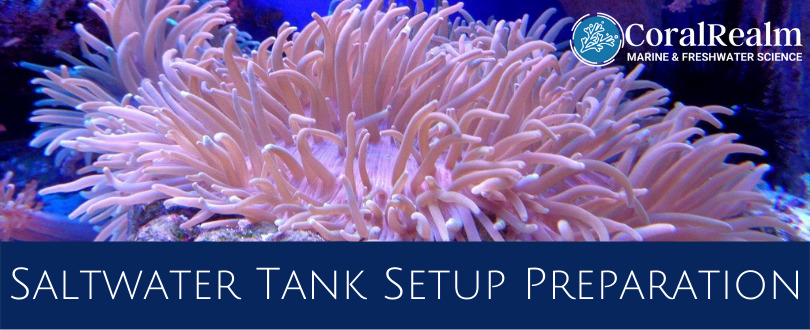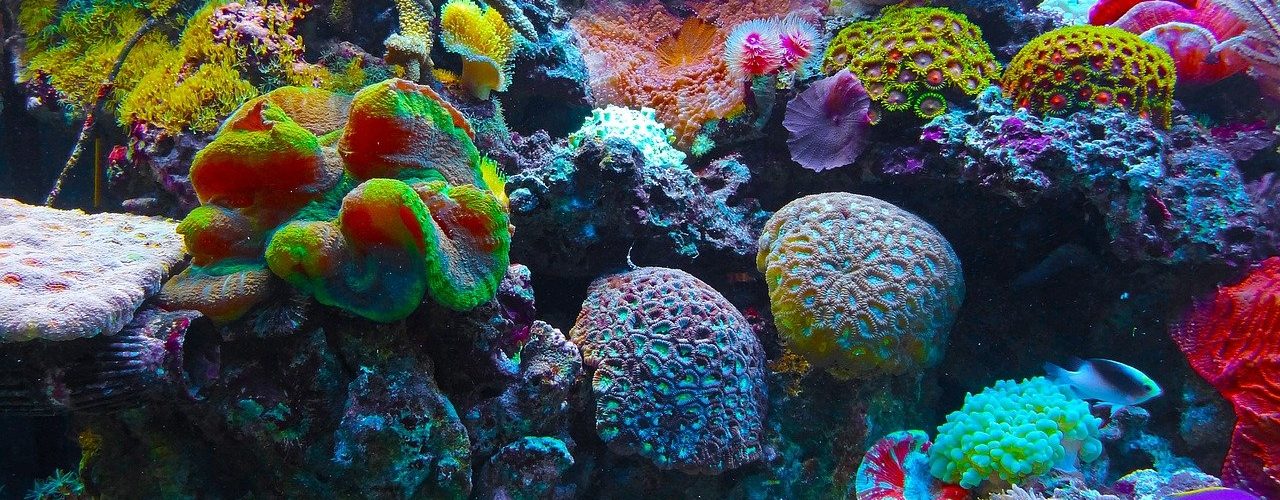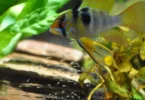Last Updated on November 19, 2022 by Matt
Setting up a new aquarium is an incredibly exciting process. Aquariums have been proven to be beneficial to mental health, and can help with sleep and stress levels as well. But not only this, having full control of your saltwater tank setup enables you to choose your substrate, decorations, invertebrates, and fish.
The best advice to anyone starting out with their first saltwater tank setup is to be prepared. While setting up a saltwater tank is similar to setting up a freshwater tank, there are more steps and it is a little bit more complicated.
However there are a multitude of different animals that you could house in saltwater, from corals and invertebrates to a plethora of colorful fish species. A saltwater tank is well worth the effort! Follow this saltwater tank setup guide to ensure that your new tank gets started on the right foot.
IN THIS ARTICLE
Preparation

When setting up any aquarium, preparation is key in making sure the process is as smooth and stress-free as possible. This is even more true for saltwater aquariums, as there is a little more to it than with freshwater tanks. For example, you will need a sump tank and protein skimmer as a minimum. However with starter tanks these often come attached.
1) Choose your display tank:
First things first, choose your display tank. The display tank is where your fish and corals will be, and what you will see on a day to day basis. If you are an absolute beginner, you can get starter tanks with a sump tank attached which will house the protein skimmer and filtration mechanism. If this is the case you can skip to step 4. These tanks are often small with limited space, so if you want a larger tank, carry on reading.
Aquariums can either be glass or plastic, with both having their pros and cons; there isn’t an option which is clearly better than the other. Glass aquariums are easier to clean as they are scratch resistant, but are heavy, while acrylic tanks are available in a range of shapes but are prone to scratching and can become yellowed over time. Do your research and choose the best option for your circumstances.
Aquariums come in a huge range of sizes, from nano tanks and small tanks of 5 and 10 gallons to huge tanks in the 100’s gallons. Most saltwater aquarium fish have a minimum tank size requirement, so if you are getting an aquarium specifically to get a certain fish, such as a clownfish with a sea anemone, then make sure the tank is the required size.
2) Choose a sump tank:
Once you have your display tank chosen, you can then buy a sump tank. The sump tank will contain all the filtration equipment for your tank, as well as additional equipment such as an auto top up system. Small tanks may have a side area for this, but most marine aquariums will require a sump tank.
In general, the sump tank should be at least 25% of the display tank’s volume. This means that for a 50 gallon tank the sump should be at least 12.5 gallons. However the bigger the better, and a larger sump will mean better water quality.
The sump tank needs to be able to fit into your cabinet or stand with room for all the necessary filtration equipment such as a canister filter and protein skimmer, as well as an auto top off system if you want one.
3) Choose equipment:
The equipment that you get for your tank is just as important as the tank itself. Your fish will be living in an environment maintained and cleaned by this equipment, so it’s important to get the correct ones.
For a saltwater tank you will need appropriate aquarium lighting, an aquarium heater, and a protein skimmer. A circulation pump or powerhead is a necessity as well. An auto top off system can be very useful, and an RODI water system can be a lifesaver too. If you are wanting to grow corals a calcium reactor will save a lot of hassle as well, otherwise you will need to keep the aquarium supplied with enough calcium manually. You will also need biological filtration media and chemical filtration media. In simple sump setups these are just placed in media bags in the sump, while advanced setups will use a media reactor for chemical filtration and a refugium for biological filtration.
There are many different brands and options available, so do your research as to which equipment is best for you. For instance if you are wanting to grow coral there are LED lights available which produce the light spectrum corals need for photosynthesis. For instance the Fluval Sea 3.0 is brilliant for coral growth. There are both HOB filters and canister filters available. In general for saltwater tanks, these aren’t used because of the risk of nitrate loading as the mechanical filtration media gets clogged. However they can be useful to place chemical and biological filtration. The protein skimmer will act as the main filtration for saltwater tanks.
4) Get an aquarium stand:
The aquarium stand is a very important part of any tank setup. Most importantly, it needs to be able to safely take the weight of your display tank on top, and the sump tank underneath. Equally as important there needs to be enough space inside the stand for the sump tank and tank equipment.
As it will be something you’ll be looking at daily, it’s also important that it looks the part. There are some great fish tank stands available online – Amazon in particular has a great range. Ideally the aquarium stand will have doors so that you can hide the unsightly sump tank. While you can make the sump tank look amazing with saltwater plants to aid filtration, most likely it will look a bit of a mess with all the equipment.
5) Choose your space:
The placement of a saltwater tank setup is important to ensure the long term health of the aquarium. Most importantly, have the aquarium in a room where you spend a lot of time. There’s no point going to the trouble and expense of setting up a saltwater tank to not be able to enjoy it properly! Aquariums have also been proven to give health benefits such as reduced stress and anxiety, so you want to be able to take advantage of these benefits. Fish can also learn to recognize their owners, and get excited to see them (probably for food!), so the more you interact with the aquarium the better.
It is also very important to consider the long term health of the aquarium. Don’t place the tank in direct sunlight. If an aquarium is in direct sunlight it can affect the temperature of the water. Sunlight can warm water quite dramatically, and fish, and especially corals, are sensitive to temperature fluctuations. Being in direct sunlight will also run the risk of causing an algal bloom. Unwanted algal growth is not only unsightly, but affects the water chemistry and quality. As the algae dies and starts to decompose ammonia and phosphate will be released. Ammonia is very toxic to fish, and even in small quantities will cause ammonia poisoning in fish. Through the aquarium nitrogen cycle ammonia will be broken down to nitrite, also toxic, and then nitrate, which is only toxic in high quantities. Nitrate poisoning is still very serious. An algal bloom will generate a lot of ammonia and overload this process, potentially poisoning and killing your fish. Corals are very sensitive to phosphate levels, so a phosphate remover should be used if high levels are found.
You also want to keep in mind the ease of maintenance when placing the aquarium. Saltwater tanks will need regular cleaning and maintenance, so you want to make it as easy as possible for yourself to reach the tank and sump, and all the equipment.
Setting up a Saltwater Aquarium
In this section we will run through how to start your saltwater tank setup and in what order you should do it to successfully set up your saltwater aquarium.
6) Install equipment:
One you have chosen where you are putting your new tank, and you have the sump and display tank on the cabinet, the first thing to do is to install the equipment.
The sump tank needs to be connected to the main display tank. Normally the water is supplied to the sump via an overflow box situated in the main tank. This water flows down simply via gravity. Once it has gone through the sump system it is then pumped back into the tank.
Put the protein skimmer into the sump tank, and get the filter ready and set up. Get the lighting system you have chosen ready and in place, and turn them on to ensure it is working correctly. Do the same with every bit of equipment that you have bought for the tank.
7) Run a wet test:
The next step is to run a wet test. For ease, just use freshwater. There’s no point in using saltwater for a wet test. A wet test is run to ensure that there are no leaks or malfunctions in the entire aquarium system. Fill the aquarium and the sump will water and turn on all the equipment and pumps. Check all the fittings and seals or any hint of leaks. It is much better to be aware of leaks at this stage of the saltwater tank setup process, as it is relatively easy to drain the water and fix leaks or problematic equipment.
Turn on all the equipment you have to ensure everything works properly and is functional. As it is freshwater the protein skimmer won’t collect foam, but you can check the depth of water it needs and that it draws water properly.
An important step in the wet test is to turn off the power to the tank and all equipment to simulate a power outage. Check that the tank and sump don’t overflow. If they do, then you will need to rejig the water level and pumps.
After running the wet test, take out as much water as you can, but it doesn’t need to be completely dry.
8) Add substrate, live rock, and decorations:
Once the wet test is complete, it is time to add your chosen substrate and live rock. Choose the substrate based on the fish and corals that you want to house in the tank. Some fish prefer sandy substrate, while others prefer rocky substrates. Live rock is important in a saltwater tank setup as it acts as a biological filter, helping to remove dangerous continents from the water column. You may have heard of curing live rock before putting it into a tank. But as you are setting up a new saltwater tank setup, this doesn’t need to be done. The curing process will take place when you cycle the tank.
Adding the decorations before the water can be useful as you can make easy adjustments and get everything how you like it. Also anything you put into the tank will raise the water level a small bit, so adding décor after can affect the water level.
Check the substrate you have chosen as to how to add it appropriately. Many substrates need to be washed first to remove dust and any contaminants. Some are best added before the water is put into the tank, and some are best added after, so check which is best for yours. The live rock is placed on top of the substrate.
9) Add water and reach desired salinity:
Now that all that is done, it is time to add the water and reach the salinity that you need. Use RODI water, or at least RO water. RODI water stands for reverse osmosis deionized water. This water has been treated to remove all toxins and contaminants and is very pure water. If you don’t have an RODI system, then it can be found in most pet stores for sale.
Once you have filled the tank, add the aquarium salt. You should use specialist marine and reef salts to reach the desired salinity. These salts can be found tailor made to fish only tanks, SPS coral tanks, and LPS coral tanks. Acan corals are a common LPS coral found in aquariums. Use the one most appropriate for your saltwater tank setup. Usually not only will these products enable you to achieve the required salinity but will also contain nutrients and minerals needed to keep your aquarium inhabitants healthy.
A pro tip is to add the salt slowly, and keep checking the salinity until you have reached the desired level. It is very easy to suddenly have very salty water!
10) Cycle the tank:
Now that all the substrate, décor, and water is in the tank, the next step is to cycle the tank. Cycling the tank is one of the most important steps to take in setting up a saltwater tank. It allows the water chemistry to settle and the good bacteria in the tank to proliferate. Good bacteria is found in the substrate and the biological filtration media. This bacteria removes ammonia and nitrite from the water column and converts it to nitrate through the nitrogen cycle.
Cycling the tank involves turning on all the equipment and leaving it to run for a couple of weeks. As the aim is to breed the beneficial bacteria, using an aquarium bacteria supplement such as Seachem Stability or Api Quick Start is highly recommended. Using a supplement specifically for saltwater will speed up the cycling process massively.
Keep an eye on the levels of ammonia, nitrite, and nitrate throughout the process, and once they have all plateaued then the cycling process is done.
12) Add your fish:
The final step is the most enjoyable. It’s finally time to add your fish!! There will always be a slight difference in water conditions such as temperature, pH, and water hardness between your tank and the store tank. It is important therefore to acclimatize the fish before you release them into the tank.
It is also important to realize that your marine aquarium is in fine balance in terms of water chemistry. Adding anything live into your tank will give the tank a big shock as they produce ammonia as they respire. Ammonia is very toxic to fish, and is removed from the water column by plants and bacteria. Adding fish one by one will prevent the amount of ammonia being produced overloading the tank and causing a poisoning event in the tank.
In general fish add a lot more to the bioload of the tank than corals or other invertebrates, although some snails are big waste producers. As you add more inhabitants, keep an eye on water chemistry, especially ammonia, nitrite, and nitrate levels. Make sure to clean your tank regularly during these times. If you are wanting to add a lot of fish, resist the temptation to add them all at once, and instead add them over a number of weeks. Using an aquarium bacteria supplement will aid in preventing an ammonia spike and enable you to add more fish on a more regular basis. Don’t overstock your tank though, as you will end up with lots of problems!
13) Finally enjoy your saltwater tank setup!
The bonus final step is to sit back with a glass of something special, look at the tank, and enjoy all your hard work! It’s been a long slog, but you can finally properly enjoy watching the personalities of your new fish emerge as they get to know both you and their new tank. You may not think it but fish can recognize you!








